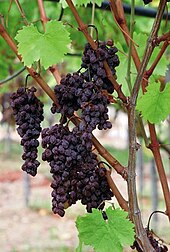This article needs additional citations for verification. (May 2022) |



Straw wine, or raisin wine, is a wine made from grapes that have been dried off the vine to concentrate their juice. Under the classic method, after a careful hand harvest, selected bunches of ripe grapes will be laid out on mats in full sun. (Originally the mats were made of straw, but these days the plastic nets for the olive harvest are likely to be used). This drying will probably be done on well exposed terraces somewhere near the wine press and the drying process will take around a week or longer. Small scale productions were laid out on flat roofs; however, if this still happens, it is extremely rare nowadays.
Under less labour-intensive versions of the technique, easily portable racks might be used instead of mats or nets, or the grapes are left lying on the ground beneath the vines, or even left hanging on the vine with the vine-arm cut or the stem twisted. Technically speaking the grapes must be cut off from the vine in order for the wine to be a 'straw wine'. If the grapes are just left to over-ripen before being harvested, even if this is to the point of raisining, this is a 'late harvest' wine.
The exact technique used varies according to local conditions, traditions and increasingly modern innovations. In some regions the grapes are laid first in the sun and later covered or they are covered at night to protect them against dew fall. In cooler, damper regions, the entire drying process takes place indoors in huts, attics or greenhouses with the bunches lying on racks or hanging up with good air circulation.
Straw wines are typically sweet to very sweet white wines, similar in density and sweetness to Sauternes but potentially sweeter. They are capable of long ageing. The low yields and labour-intensive production method means that they are quite expensive. Around Verona red grapes are dried, and are fermented in two different ways to make a strong dry red wine (Amarone) and a sweet red wine (Recioto della Valpolicella).